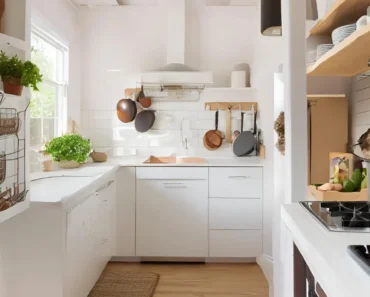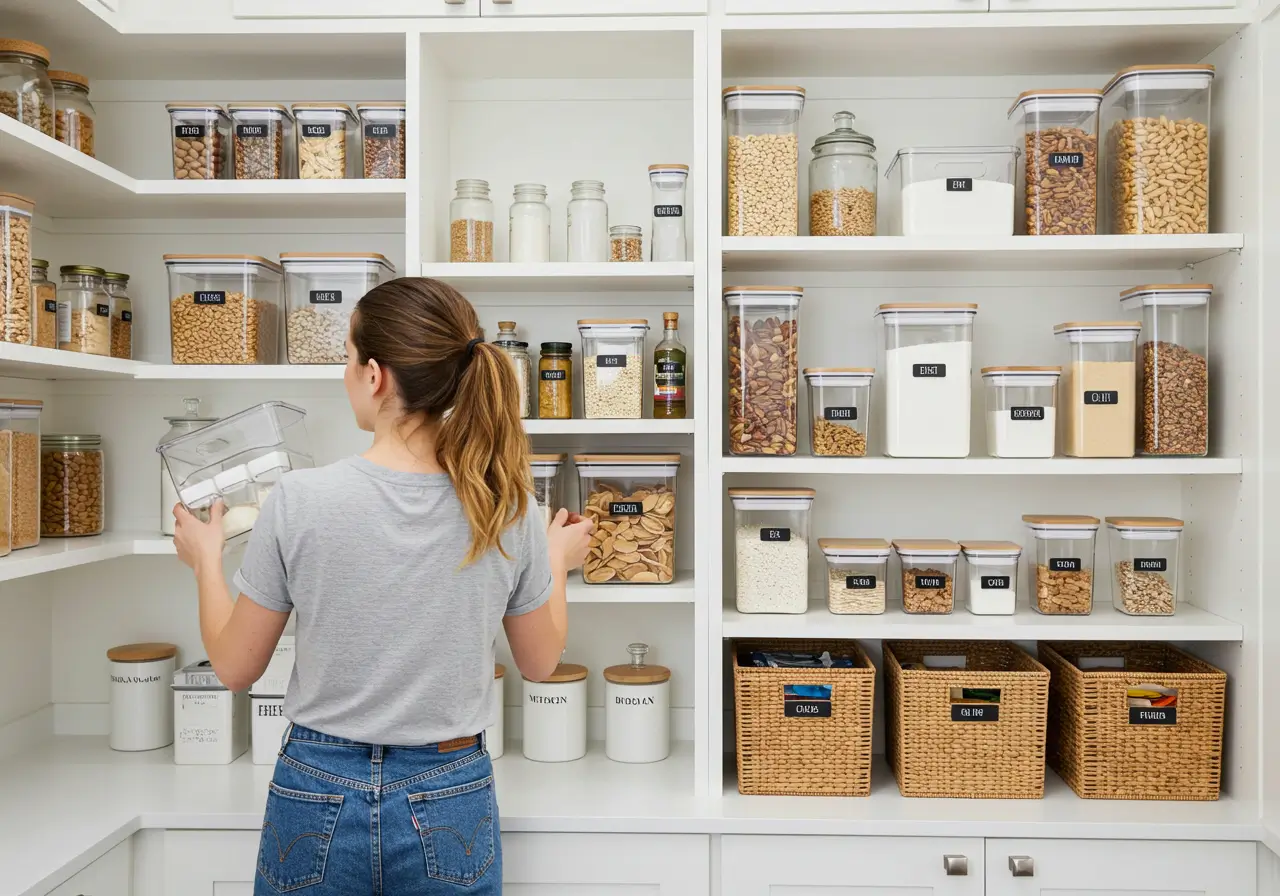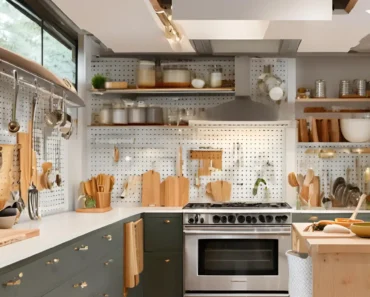Deep pantry shelves can be both a blessing and a curse. While they offer ample storage space, their depth often leads to a chaotic abyss where items get lost, forgotten, and become difficult to access. Organizing your Deep Pantry Shelves effectively isn’t just about aesthetics; it’s about maximizing efficiency, reducing food waste, and making your kitchen a more functional and enjoyable space.
Transforming your deep pantry from a source of frustration into a well-ordered haven requires a strategic approach. With the right techniques, you can ensure every inch is utilized wisely and every item is within easy reach, or at least easily discoverable.
This guide provides 5 expert tips for organizing your Deep Pantry Shelves for maximum efficiency. We’ll cover smart storage solutions and practical methods to help you conquer the clutter and create a pantry system that truly works for you and your family.
5 Expert Tips for Organizing Your Deep Pantry Shelves for Maximum Efficiency
Tip 1: Categorize and Zone Your Items Strategically
The first step to taming Deep Pantry Shelves is to group similar items together. This creates logical zones and makes it much easier to find what you need and see what you have.
Effective Grouping:
Create Broad Categories:
Think about how you use your pantry items. Common categories include baking supplies, breakfast foods, snacks, canned goods, grains and pasta, oils and vinegars, and beverages.
Designate Zones:
Assign specific shelves or sections of shelves to these categories. For Deep Pantry Shelves, you might place frequently used categories towards the front or at mid-height, and less-used ones further back or higher up.
Front-to-Back Logic:
Within a zone on a deep shelf, place items of the same category front to back. For example, all your canned tomatoes together, rather than mixed with other canned goods.
Why It Works for Deep Shelves:
Reduces Searching Time:
You’ll know exactly where to look for a particular item, even if it’s towards the back.
Inventory Management:
It’s easier to see at a glance what you’re running low on within a specific category on your Deep Pantry Shelves.
Tip 2: Utilize Pull-Out Solutions and Tiered Organizers
Accessibility is key for Deep Pantry Shelves. Organizers that bring items to you or improve visibility can make a world of difference.
Smart Organizers:
Pull-Out Drawers or Baskets:
These are game-changers for deep shelves. Installing sliding drawers or using deep bins that can be pulled out allows you to easily access items stored at the very back without having to remove everything in front.
Tiered Shelf Risers (Stadium Organizers):
Ideal for canned goods, spices, or jars. Tiered risers elevate items in the back, so you can see everything at once, preventing items from getting lost behind others.
Lazy Susans (Turntables):
Perfect for corners or for grouping smaller items like oils, vinegars, or spices. A quick spin brings everything into view and within reach on your Deep Pantry Shelves.
Why It Works for Deep Shelves:
Maximizes Usable Space:
These solutions help utilize the full depth of the shelf efficiently.
Improves Visibility and Access:
No more forgotten items languishing in the dark depths of your pantry.
Tip 3: Employ Clear, Stackable Containers
Decanting pantry staples into uniform, clear containers not only looks neater but also significantly improves organization on Deep Pantry Shelves.
Container Strategy:
Choose Clear Containers:
See-through containers allow you to quickly identify contents and assess quantities without needing to open them. This is especially useful for items stored further back.
Opt for Stackable Designs:
Square or rectangular containers utilize space more efficiently than round ones or original bulky packaging. Stackability maximizes vertical space.
Ensure Airtight Seals:
Airtight containers keep food fresher for longer, which is crucial for items that might be stored for extended periods on Deep Pantry Shelves.
Why It Works for Deep Shelves:
Enhanced Visibility:
Easily spot what you need, even from a distance or when peering into the back of the shelf.
Space Optimization:
Uniform containers eliminate wasted space caused by irregularly shaped packaging.
Food Preservation:
Reduces food spoilage and waste.
Related Posts: From Chaos to Clarity: How Can Food Organizer
Tip 4: Implement a First-In, First-Out (FIFO) System
A FIFO system helps ensure that older items are used before newer ones, minimizing food waste, which can be a common issue with Deep Pantry Shelves.
Rotation Practice:
Stock from the Back:
When you buy new groceries, place them at the back of the relevant category on the shelf.
Pull from the Front:
Always use the items from the front of the shelf first. This naturally rotates your stock.
Check Expiration Dates:
Periodically glance at expiration dates, especially for items you don’t use frequently. Consider labeling containers with purchase or expiration dates if helpful.
Why It Works for Deep Shelves:
Reduces Spoilage:
Prevents older items from being forgotten and expiring at the back of your Deep Pantry Shelves.
Saves Money:
By using what you have before it goes bad, you’ll reduce the need to repurchase items.
Tip 5: Label Everything Clearly and Maintain Regularly
Clear labeling and consistent maintenance are crucial for keeping your Deep Pantry Shelves organized in the long term.
System Upkeep:
Label Containers and Bins:
Clearly label all containers, bins, and even shelf edges if it helps. This ensures everyone in the household knows where things belong and what’s inside.
Schedule Regular Check-ins:
Dedicate a few minutes each week or every other week to quickly tidy and put things back in their designated zones.
Perform Periodic Deep Cleans:
Every few months, take time to wipe down shelves, check for expired items, and reassess if your current organization system is still working for your Deep Pantry Shelves.
Why It Works for Deep Shelves:
Maintains Order:
Prevents the pantry from slowly reverting to chaos.
Ensures System Adherence:
Labels make it easy for everyone to follow the organizational system.
Keeps Pantry Fresh and Functional:
Regular maintenance ensures your Deep Pantry Shelves remain an efficient and pleasant space.
Conquer Your Deep Pantry Shelves for Lasting Efficiency
Organizing Deep Pantry Shelves might seem like a daunting task, but by implementing these five expert tips, you can transform them into highly efficient and accessible storage spaces. Categorizing, using smart organizers, decanting into clear containers, practicing FIFO, and maintaining your system will significantly improve your kitchen workflow and reduce daily frustrations.
Embrace these strategies, and you’ll find that your Deep Pantry Shelves can become one of the most well-utilized and appreciated areas of your home, making meal prep and grocery management a breeze.
Frequently Asked Questions (FAQs)
1. What are the best types of containers for deep pantry shelves?
Clear, stackable, and airtight containers are ideal. Look for square or rectangular shapes to maximize space. Various sizes will be needed for different items like flour, sugar, pasta, cereals, and snacks. Brands like OXO Pop, ProKeepers, or even budget-friendly clear pantry bins can work well.
2. How do I stop items from getting lost at the back of my deep pantry shelves?
The best solutions are pull-out drawers or baskets, tiered shelf risers (stadium organizers), and turntables (Lazy Susans). These bring items at the back forward or make them more visible. Also, consistently applying the First-In, First-Out (FIFO) method helps rotate stock.
3. How often should I reorganize my deep pantry shelves?
A quick tidy-up and ensuring items are in their correct zones can be done weekly or bi-weekly as you put groceries away. A more thorough reorganization, including wiping shelves and checking all expiration dates, is recommended every 3 to 6 months, or as needed, for your Deep Pantry Shelves.
4. Are there any budget-friendly solutions for organizing deep pantry shelves?
Absolutely. You can start by repurposing shoeboxes or other sturdy boxes as makeshift bins. Dollar stores often have affordable plastic bins and baskets. You can create DIY tiered risers using sturdy, flat pieces of wood or even unused canned goods. The key is to first categorize and then find containers that fit your budget.
5. What’s the first step I should take to organize my deep pantry shelves?
The very first step is to completely empty your Deep Pantry Shelves. Take everything out. Then, clean the shelves thoroughly. Next, sort through all your items, discarding anything expired or no longer needed. Finally, categorize your items before you start placing them back using your new organizational strategies.



